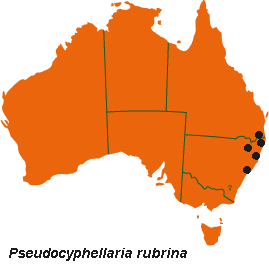



Australian Biological Resources Study
| Checklist of the Lichens of Australia and its Island Territories | ||
| Introduction | A–D | E–O | P–R | S–Z | Oceanic Islands | References | ||
| Pseudocyphellaria rubrina (Stirt.) D.J.Galloway | ||
| Lichenologist 17: 306 (1985); Parmosticta rubrina Stirt., Trans. & Proc. Roy. Soc. Victoria 17: 69 (1881); Sticta rubrina (Stirt.) Müll.Arg., Flora 66: 23 (1883). T: Brisbane, Qld, F.M.Bailey 11; holo: BM. ***** Sticta flavissima Müll.Arg., Flora 66: 21 (1883) p.p. min. T: Toowoomba, Qld, C.H.Hartmann; holo: G 001996. ***** Sticta aurata var. pallidoglaucescens C.Knight, in J.Shirley, Proc. Roy. Soc. Queensland 6: 31 (1889). T: Mt Mistake Range, Qld, J.Shirley 203; holo: WELT, Knight Vol. 13A: 4; iso: NSW. ***** Sticta podocarpa Müll.Arg., Flora 74: 375 (1891). T: "Bei Sidney", [Sydney, N.S.W.], C.Moore; holo: G 002094; iso: BM. | ||
| Thallus rosette-forming to irregularly spreading, loosely to closely attached centrally, 5–10 (–15) cm wide. Lobes ±linear-laciniate, 1–4 (–8) cm long, 3–8 (–12) mm wide, discrete or contiguous from margins to centre or ±complex-imbricate, subdichotomously to irregularly branched, tough, coriaceous when dry, flabby when wet, without isidia; lobe margins entire to variously notched, crenate, incised or ±pectinate, thickened above and below, without projecting pseudocyphellae. Upper surface pale greenish yellow to pale buff when dry, lettuce-green or olive suffused yellowish when wet, undulate, irregularly wrinkled or pitted to subfaveolate, occasionally minutely tomentose at apices; without maculae, phyllidia, pseudocyphellae or soredia. Medulla yellow. Photobiont green. Lower surface yellow at margins, red-brown centrally, wrinkled-puckered at margins, uniformly tomentose or ±glabrous at margins; tomentum thin to thick and felted, white to red-brown. Pseudocyphellae scattered, round to irregular, conical-verruciform, to 0.2 mm diam., yellow. Apothecia occasional, marginal, subpedicellate, 1–4 (–6) mm diam.; disc pale to dark red-brown, epruinose; exciple coarsely scabrid-corrugate, concolorous with thallus or paler, obscuring disc at first, persisting as a stellate crenulate margin; epithecium pale red-brown; hymenium colourless; hypothecium opaque, yellow-brown. Ascospores acicular, 3–6-septate, (58–) 65–90 (–104) × 3–5.5 µm, colourless. CHEMISTRY: Pulvinic acid, pulvinic dilactone, calycin, pulvinamide, pseudocyphellarin A, isopseudocyphellarin A, phenarctin, 2α,3β,22α-triacetoxystictane, 22α-hydroxystictane-3-one, 2α,3β-diacetoxystictane-22-ol, stictane-3β,22α-diol, 2β-acetoxystictane-3β,22α-diol, 3β-acetoxystictane-2α,22α-diol and stictane-2α,3β,22α-triol. |  |
|
| An Australian endemic growing on living and dead trees and on rocks in montane rainforest in south-eastern Qld and eastern N.S.W. Also in Lord Howe Is. | ||
| Galloway et al. (2001) | ||
| Checklist Index |
| Introduction | A–D | E–O | P–R | S–Z | Oceanic Islands | References |
This work is copyright. Apart from any use as permitted under the Copyright Act 1968, no part may be reproduced by any process without prior written permission from Australian Biological Resources Study. Requests and inquiries concerning reproduction and rights should be addressed in the first instance to Dr P. McCarthy. These pages may not be displayed on, or downloaded to, any other server without the express permission of ABRS.